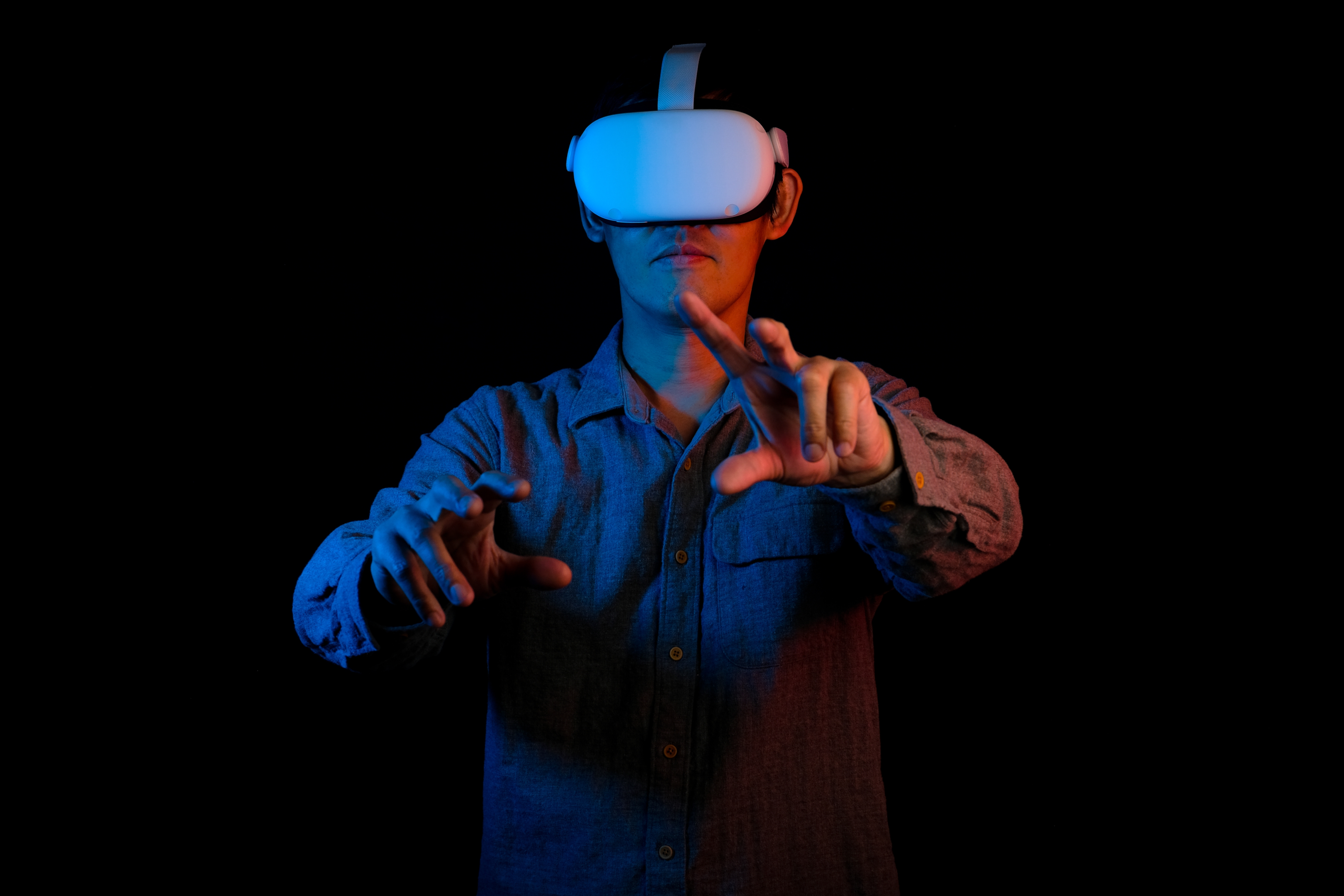What is the Metaverse? A Comprehensive Guide
13/12/2022
Unsurprisingly, when people hear the mention of metaverse technology, their minds can quickly be filled with thoughts of a dystopian matrix. Yes, it’s a new and exciting technology, but the creation of a virtual world where human beings may end up spending a lot of our time can understandably raise questions and concerns.
After changing the minds of many a technophobe, we’re well versed in helping people feel comfortable with advancing technology. The key is knowledge. As soon as someone starts to understand the technology better, you can see their jaw stop tensing so hard right in front of your eyes.
So, we wanted to provide a comprehensive guide to these new virtual worlds and answer the question – what is the metaverse? At the same time, we hope to calm any nerves surrounding the idea of a virtual universe or extended reality. We’d ask that you think of how you feel about a virtual world now, and then compare it to how you feel after reading this article.
So, the metaverse… It started as a science fiction thing, right?
Well, it did, back in the early internet days… but now it’s becoming reality. Neal Stephenson famously coined the term “Metaverse” in his novel Snow Crash, referring to 3D virtual worlds which are populated by real-life humans. Other science fiction movies also have a metaverse-like system that are sometimes preceded by some kind of death and resuscitation cycle.
Think of the matrix, as an example, where Neo was stuck in a virtual world but comes ‘back to life’ in the real world. Stephenson’s definition is pretty spot on as a simple running definition. The metaverse or metaverses are made up of online worlds that provide virtual spaces for humans to have virtual experiences. Some of these are gamified experiences, whereas some are meant to provide a second life that runs parallel to our own here in the real world.
Are we all going to live in the metaverse?…
Many consider the metaverse to be an online haven that we can take refuge in away from many of the issues that humanity currently faces. Right now, tech industry analysts who talk about “the metaverse” tend to be excited about upcoming digital platform features like improved education, mobility experiences for people who have a disability, social connectedness for the elderly, and endless digital resources meaning less resources taken from our physical planet.
…and how much will we use it?…
This is an ambition for a digital future where many limits of our physical world are addressed by technology companies in digital spaces. Now, that’s not to say that we’re all going to be stuck there 24/7. Don’t go filling your head with dystopian metaverse visions. Some hypotheses suggest that 25% of the human race will spend around an hour a day in the metaverse by 2026. Yes, that’s a big increase in the current usage of a virtual world but it’s surprisingly less than most people imagine.
Many experts believe it will simply be a space that human beings can benefit from for small amounts of time, and that our human nature won’t allow us to pull ourselves completely into a persistent virtual world. Something to ponder.
Entering the metaverse
So, metaverses represent a unified system of 3D virtual worlds. The key word here is ‘virtual’. How does one access a virtual world? Well, the world of virtual reality provides access to the metaverse via virtual reality (VR) headsets that users navigate with eye and head movements, physical feedback or speech commands.
Is virtual reality the key?
A VR headset engages the user and induces an experience called “presence”. If you’ve ever tried VR, you would know the feeling – it really does feel as if you are present in and online world. Through VR headsets, the Metaverse can be engaged with through a wide array of popular multi-player virtual-reality games like Rec Room or Horizon Worlds where users take on avatars for interaction. However, the wider application outside the gaming world is staggering.
In fact, the metaverse is likely what will happen in the future for majority of our internet interactions. We will likely access the metaverse to purchase virtual items for ourselves and our avatars, to do business as part of the virtual economy, to use social media, and simply for a unique virtual reality experience.
Meta knows what’s up…
The news of a more sophisticated virtual reality space comes nearly a year after Facebook announced that it would be rebranding to Meta. Meta has built an online VR social network that facilitates video game creation and social engagement. There still remain a number of legal and commercial challenges to humanities growing engagement in Meta platforms but leaders of tech giants like Mark Zuckerberg are committed to making a mixed reality a reality.
More than virtual reality (VR)

As mentioned, the metaverse still must overcome obstacles before it will become widely adopted worldwide. A major challenge is the “virtual” side of things. While VR has traditionally been considered as an essential ingredient in the Metaverse recipe, entry into the metaverse is not restricted to VR headsets and can’t be if it wants success. Access to the metaverse through augmented reality is on the rise as tech companies begin to realise that getting humans to slide on a VR headset and shut off the outside world is proving more difficult than they originally thought.
In comes AR to save the day
Tech such as augmented reality glasses are being developed so that the metaverse can run parallel to the real world. Augmented reality essentially means bringing the metaverse and our digital avatars into the real world. Through these glasses we’ll see parts of the metaverse projected into our own world, just like how Google maps can be projected onto the road with those fancy heads up displays in new cars.
There’s a sweet crossover point between virtual and augmented reality which tech giants see as an opportunity to ease people into the use of the metaverse. Even without AR glasses, anyone using computers or smartphones can now use metaverse experiences such as Second Life. It’s essential that businesses offer easy access to broader consumers if they want to succeed. VR markets have seen tremendous innovation in a short period, but it will take time for humans to make frequent use of them and tech companies know it.
Transitioning to a virtual world through augmented reality
So, augmented reality experiences might help metaverses achieve their full potential. AR allows users to use their smartphone (or another device) for visual enhancement and virtualization so they can also explore a virtual space by tapping into a virtual environment via mobile internet.
A metaverse that is built upon augmented realities will not create entirely new digital worlds – it will merge in real life. Some consider these new technologies to be an even more intimidating metaverse experience than VR. But it’s likely augmented reality will be such a smooth and immersive experience that we won’t realise it’s happened until we suddenly find ourselves in an embodied internet experience.
Are these virtual worlds really useful?
Short answer, yes. The metaverse is widely considered the most important player in growing the digital economy and the next internet. It provides the building blocks for increased use of non-fungible tokens, the new digital finance of metaverse worlds. But aside from economic benefit, the metaverse today is already providing extreme benefits. Some examples are:
- Social connectedness for the elderly
- More effective education
- Better health training
- Movement experiences for people with disabilities
- Increased empathy
- Reduced use of resources
For example, imagine a teacher being able to take their class to the Jurassic period… like, quite literally transport them there in a history class. They could all walk under a t-rex together and run up the back of a brachiosaurus. Then imagine the amount of printing that would be saved in one classroom alone because everything can be provided digitally. Digital paper, digital pens, digital computers. The number of resources that could be saved would be phenomenal.
Experts believe the metaverses best-case use will largely serve educational purposes. 3D immersive learning would certainly be much more beneficial than learning via a simple lecture.
Further benefits
Some smaller companies are even creating internet experiences that allow people to play games that help them build empathy. For example, tech company Equal Reality in Australia is placing employees of businesses in the shoes of marginalised individuals in virtual worlds. It allows the individual to experience first-hand what discrimination might feel like. The training is proving extremely successful in building empathy and understanding for employees.
Finally, the metaverse has been described as the future of entertainment, fashion, gaming or even partying. With virtual reality headsets on, people could attend shows by their favourite artists from the comfort of their own couch.
Tell me about the real metaverse

Okay, okay, let’s address the elephant in the room – is there a potential dark side to the metaverse? Well unlike video games with their strict ratings, the metaverse could fall victim to a lack of regulation and government oversight. As mentioned, the metaverse is proving a replacement for the internet as we know it.
So, unsurprisingly, one company now known as Meta, formerly Facebook, is the company with the most shares in the Metaverse. They are not building just one platform, but many interconnected platforms like we experience with social media apps today. They obviously see it as an investment opportunity as they are pumping billions of dollars into development.
Money, money, money?
We all know that when it comes to money, things can take an ugly turn. We’re not going to sugar coat it; we do share some of the concerns of technophobes. We just believe that embracing it in the right way is more effective at steering us in the right direction than flat out refusal to engage with new technology.
The metaverse could take humans to a place where we spend substantial amounts of time on the internet. Do we already do this? Of course, with record amounts of time spent on social media apps and video games. Will mixed reality potentially trap us further in the internet? Tech companies would argue that’s up to us as individuals.
So, it’s not just a video game?
Well, yes and no. Many people look at it as a video game, and there are many video games built into and around the metaverse. Fortnite is a good example of this, allowing players to take on avatars and earn real digital currency in a digital economy.
Epic Games who created Fortnite are now developing the game into a metaverse world, which would be extremely popular with an already massive fan base. However, that’s not the metaverse experiences that many of us imagine when we associate virtual reality with the matrix per say.
Ah yes, isn’t that the matrix?

Second Life might be more in line with our imaginings as the closest existing iteration to an envisioned metaverse. It’s a simulation that allows players in virtual reality the possibility of shopping, eating, working, and even bathing. Auto companies are quickly jumping on board to sell cars in this simulation world. The name says it all. It’s meant to be a second life.
People say NFTs are part of the metaverse. Why?
When it comes to finance on the metaverse, NFTs come to the rescue. NFTs are an effective means to identify the owner of virtual goods. Creation and transfer of virtual goods are part of the metaverse hence NFTs are a potential financial solution to the metaverse. Moreover, if you buy a virtual shirt on metaverse platform A, NFTs will create a receipt that will allow you to redeem a similar shirt on metaverse platforms X Y Z.
How do I access the metaverse for now?
Finally, you understand the metaverse. Hopefully we’ve eased any concerns you had, or perhaps we’ve only heightened them. Whichever side of the fence you sit on, if you’re wanting to give the metaverse a go for yourself and make up your own mind as is your own right, then you’ll need the right gear.
The gear to get your hands on
We’re not just talking game consoles. Business insider experts recommend purchasing the necessary hardware. These range from the affordable $20 Google Cardboard to the $300 Oculus quest 2 headset or the high-tech $999 Valve Index XR headset, according to your budget. Cyber security expert Baggili says that the structure of the metaverse is currently similar to the ones of the App Store so it’s fairly user friendly and easy to manager.
See you in there!
Most importantly, we encourage you to get on, have a go and see for yourself what all the metaverse hype is about. Perhaps there’s a direct benefit to you as an individual, or perhaps you’ll think of ways it could benefit people you know (got a teacher in the family?). Have fun, explore, and create new memories with friends in virtual reality.
Keep an eye out while you’re in there, we might see you round!





